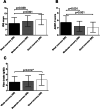Sleep-time physiological recovery is associated with eating habits in distressed working-age Finns with overweight: secondary analysis of a randomised controlled trial
- PMID: 34183032
- PMCID: PMC8237494
- DOI: 10.1186/s12995-021-00310-6
Sleep-time physiological recovery is associated with eating habits in distressed working-age Finns with overweight: secondary analysis of a randomised controlled trial
Abstract
Background: Association of physiological recovery with nutrition has scarcely been studied. We investigated whether physiological recovery during sleep relates to eating habits, i.e., eating behaviour and diet quality.
Methods: Cross-sectional baseline analysis of psychologically distressed adults with overweight (N = 252) participating in a lifestyle intervention study in three Finnish cities. Recovery measures were based on sleep-time heart rate variability (HRV) measured for 3 consecutive nights. Measures derived from HRV were 1) RMSSD (Root Mean Square of the Successive Differences) indicating the parasympathetic activation of the autonomic nervous system and 2) Stress Balance (SB) indicating the temporal ratio of recovery to stress. Eating behaviour was measured with questionnaires (Intuitive Eating Scale, Three-Factor Eating Questionnaire, Health and Taste Attitude Scales, ecSatter Inventory™). Diet quality was quantified using questionnaires (Index of Diet Quality, Alcohol Use Disorders Identification Test Consumption) and 48-h dietary recall.
Results: Participants with best RMSSD reported less intuitive eating (p = 0.019) and less eating for physical rather than emotional reasons (p = 0.010) compared to those with poorest RMSSD; participants with good SB reported less unconditional permission to eat (p = 0.008), higher fibre intake (p = 0.028), higher diet quality (p = 0.001), and lower alcohol consumption (p < 0.001) compared to those with poor SB, although effect sizes were small. In subgroup analyses among participants who reported working regular daytime hours (n = 216), only the associations of SB with diet quality and alcohol consumption remained significant.
Conclusions: Better nocturnal recovery showed associations with better diet quality, lower alcohol consumption and possibly lower intuitive eating. In future lifestyle interventions and clinical practice, it is important to acknowledge sleep-time recovery as one possible factor linked with eating habits.
Trial registration: ClinicalTrials.gov Identifier NCT01738256 , Registered 17 August 2012.
Keywords: Dietary behaviour; Heart rate variability; Intuitive eating; Parasympathetic activity; Stress.
Conflict of interest statement
T.M. is currently an employee and stockowner of Firstbeat Technologies Ltd., Jyväskylä, Finland. At the time that the Elixir intervention study was designed and conducted, he worked at the University of Jyväskylä. He did not participate in data analysis or writing the conclusions. No other conflicts of interest are declared by the authors.
Figures


References
-
- Suvisaari J, Viertiö S, Solin P, Partonen T. Mental health. In: Koponen P, Borodulin K, Lundqvist A, Sääksjärvi K, Koskinen S, editors. Health, functional capacity and welfare in Finland - FinHealth 2017 study. Helsinki: National Institute for Health and Welfare (THL); 2018. pp. 85–89.
-
- Lundqvist A, Männistö S, Jousilahti P, Kaartinen N, Mäki P, Borodulin K. Obesity. In: Koponen P, Borodulin K, Lundqvist A, Sääksjärvi K, Koskinen S, editors. Health, functional capacity and welfare in Finland - FinHealth 2017 study. Helsinki: National Institute for Health and Welfare (THL); 2018. pp. 45–49.
-
- Partonen T, Lundqvist A, Wennman H, Borodulin K. Sleep. In: Koponen P, Borodulin K, Lundqvist A, Sääksjärvi K, Koskinen S, editors. Health, functional capacity and welfare in Finland - FinHealth 2017 study. Helsinki: National Institute for Health and Welfare (THL); 2018. pp. 42–44.
-
- Theorell T. Anabolism and catabolism - antagonistic partners in stress and strain. Scand J Work Environ Health. 2008;(6):136–43.
Associated data
Grants and funding
LinkOut - more resources
Full Text Sources
Medical

